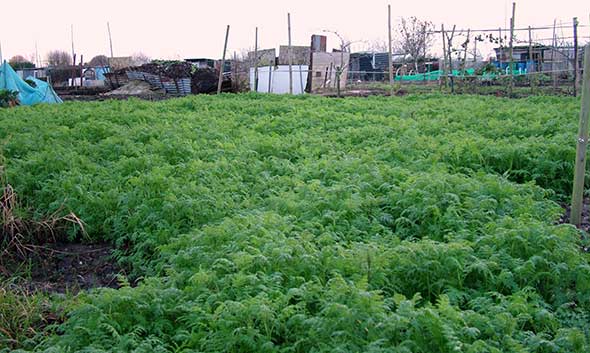Green manure is a crop that is grown specifically for digging in to improve soil fertility. This process adds nutrients and organic matter to the soil, bringing nutrients closer to the surface where other crops will be able to access them.
Legumes such as field beans and lupins are also able to fix nitrogen into the soil through nodules in their roots. Once these are dug in, the nitrogen is slowly released into the soil, making it available to the next plants you grow. Providing green manures are dug in before they flower, they do not make a nuisance of themselves by re-seeding and re-growing.

As well as adding nutrients to the soil, green manures provide competition for weeds that would have been taking nutrients from the soil when a plot is left empty. Red clover can be grown for example on a vacant plot to suppress weeds until you are need the space, and then it can be dug in, fixing nitrogen in the soil before planting. I use green manures mostly over the winter months as part of my crop rotation plan. I sow one of my beds in the autumn, digging it in, in late spring. You can also sow green manures in spring for digging in during the summer or autumn, although there are a few that are very fast growing such as Mustard (sinapsis alba) that can even be sown between other crops if there is enough goodness in your ground for it to grow well. The list of green manures below will help you decide on the most suitable to sow for the time of year.
Green manure should be dug in before it flowers and certainly before it becomes too woody because this will take nitrogen from the soil during the decomposition process. If your crop becomes tall, it is usually best to cut it down with the mower first (without the collection box attached) before digging it in. This will make the decomposition process faster.
Allowing the crop to wilt before digging it in can also help to break the crop down quickly. This can be done by cutting the crop with a spade or by carefully using a rotavator. Tall stems can even be thrashed with a long stick.
After a few days when the crop has wilted, it can be dug in, or rotavated fully into the soil to a depth no deeper than 6-8 inches.
The following plants are regarded as green manures and fix nitrogen into the soil:
Lupin (lupines augustifolius)
The lupin is a tall legume that adds phosphates and fixes nitrogen. Sow in spring, dig in during the summer.
Alfalfa Lucerne (medicago sativa)
Alfalfa is deep rooting and produces a lot of green foliage for digging in. It fixes nitrogen in the soil but requires a complete season to grow. It can be grown as a winter crop. Sow in spring or autumn to harvest in autumn or spring.
Red Clover (trifolium patense)
Red clover is a short / low growing plant but has an extensive root system and lots of small green leaves. It can be sown in spring or at the end of summer and can be left for a long period of time when land isn’t in use and dug in when the land is required.
Broad Bean (vicia faba)
Broad beans are very hardy and will withstand even harsh winters. The beans can of course be eaten and are better when small. So in spring or in late summer / early autumn.
Winter Tare (vicia villosa)
As the name suggests, this grows over the winter. It is tall and has a lot of green foliage. Sow in late summer / early autumn.
The following green manures do not fix nitrogen into the soil:
Mustard (sinapsis alba)
Mustard is short so doesn’t take much digging in. It is very fast to grow so can even be sown in between crops. This is useful to supress weeds. It has a shallow root system so may need watering during dry weather. It is best not to use mustard if you have recently had club root infecting brassicas since it can harbour the disease.
Rye (secale cereal)
The perennial variety of Rye can be sown in autumn, for digging in the following spring.
Italian Ryegrass (lolium multiflorum)
Italian Ryegrass grows quickly and germinates even when the soil temperature is cold. For this reason, it is useful to sow in early spring, digging in as the ground is required or before it produces seed.
Buckwheat (fagopyrum esculentum)
Buckwheat is a tall crop and attracts hover flies so as well as being a beneficial green manure, it can help attract these useful predators of aphids (see <companion planting> for further information about attracting hover-flies to control aphids). Buckwheat must be sown in warm weather so sow during the summer and dig it in during the autumn.
Phacelia (phacelia tanacetifolia)
Phacelia is fast to grow so useful for growing in between crops although care must be taken not to let it go hard before digging in, or it will rob the soil of nitrogen. Sow after the risk of frost has passed and dig in approx. 7-8 weeks later.
